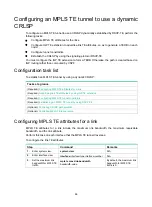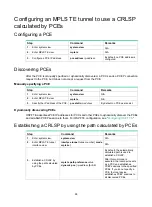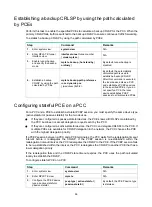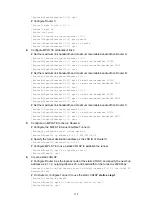
100
Configuring the active end of a co-routed bidirectional MPLS
TE tunnel
Step Command
Remarks
1.
Enter system view.
system-view
N/A
2.
Enter MPLS TE tunnel
interface view.
interface tunnel
tunnel-number
[
mode
mpls-te
]
N/A
3.
Configure a co-routed
bidirectional MPLS TE tunnel
and specify the local end as
the active end of the tunnel.
mpls te bidirectional
co-routed
active
By default, bidirectional tunnel is
disabled on the tunnel interface,
and tunnels established on the
tunnel interface are unidirectional
MPLS TE tunnels.
Configuring the passive end of a co-routed bidirectional
MPLS TE tunnel
Step Command
Remarks
1.
Enter system view.
system-view
N/A
2.
Enter MPLS TE tunnel
interface view.
interface tunnel
tunnel-number
[
mode
mpls-te
]
N/A
3.
Configure a co-routed
bidirectional MPLS TE tunnel
and specify the local end as
the passive end of the tunnel.
mpls te bidirectional
co-routed
passive
reverse-lsp lsr-id
ingress-lsr-id
tunnel-id
tunnel-id
By default, bidirectional tunnel is
disabled on the tunnel interface,
and tunnels established on the
tunnel interface are unidirectional
MPLS TE tunnels.
Configuring an associated bidirectional MPLS TE tunnel
Step Command
Remarks
1.
Enter system view.
system-view
N/A
2.
Enter MPLS TE tunnel
interface view.
interface tunnel
tunnel-number
[
mode
mpls-te
]
N/A
3.
Configure an associated
bidirectional MPLS TE
tunnel.
mpls te bidirectional
associated reverse-lsp
{
lsp-name
lsp-name
|
lsr-id
ingress-lsr-id
tunnel-id
tunnel-id
} }
By default, bidirectional tunnel is
disabled on the tunnel interface,
and tunnels established on the
tunnel interface are unidirectional
MPLS TE tunnels.
Configuring CRLSP backup
CRLSP backup provides end-to-end CRLSP protection. Only MPLS TE tunnels established through
RSVP-TE support CRLSP backup.
Perform this task on the ingress node of an MPLS TE tunnel.
To configure CRLSP backup:
















































